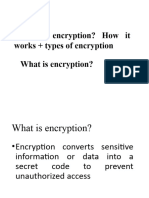0% found this document useful (0 votes)
20 views13 pagesEncryption and Decryption D1
The document provides an introduction to cryptography, explaining its purpose as a means of secure communication through techniques like encryption and decryption. It outlines two main types of encryption: symmetric-key and asymmetric-key, detailing their mechanisms and importance in protecting data. Additionally, it emphasizes the significance of data protection both at rest and in transit, utilizing various encryption methods and protocols.
Uploaded by
ukeykesiena260703Copyright
© © All Rights Reserved
We take content rights seriously. If you suspect this is your content, claim it here.
Available Formats
Download as PDF, TXT or read online on Scribd
0% found this document useful (0 votes)
20 views13 pagesEncryption and Decryption D1
The document provides an introduction to cryptography, explaining its purpose as a means of secure communication through techniques like encryption and decryption. It outlines two main types of encryption: symmetric-key and asymmetric-key, detailing their mechanisms and importance in protecting data. Additionally, it emphasizes the significance of data protection both at rest and in transit, utilizing various encryption methods and protocols.
Uploaded by
ukeykesiena260703Copyright
© © All Rights Reserved
We take content rights seriously. If you suspect this is your content, claim it here.
Available Formats
Download as PDF, TXT or read online on Scribd
/ 13




























































































